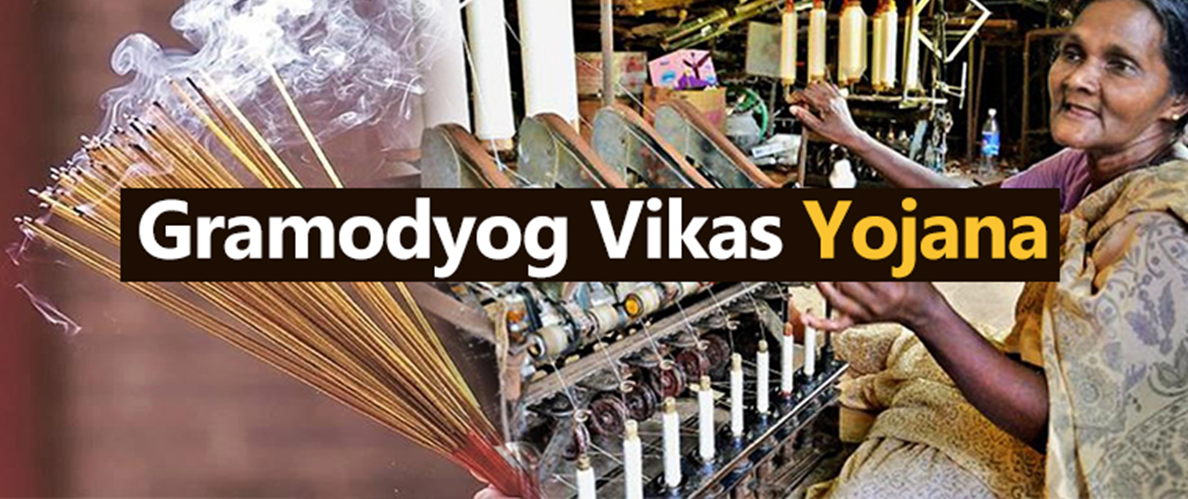
Copyright infringement not intended
Context: The Lieutenant Governor of Delhi handed over Honey Bee-Boxes and Toolkits to 130 beneficiaries on 4th July 2023, as part of the 'Gramodyog Vikas Yojana' of Khadi and Village Industries Commission (KVIC), Ministry of Micro, Small and Medium Enterprises.
Details
- The Lieutenant Governor of Delhi praised the Khadi and Village Industries Commission (KVIC) for its role in creating employment opportunities in rural India and lauded the Honey Mission launched by the KVIC in 2017 with the Prime Minister's support.
- He said that the Honey Mission has distributed more than 2 lakh bee boxes and honey colonies to more than 20,000 farmers and beekeepers, generating new sources of income and employment in rural areas.
Gramodyog Vikas Yojna (GVY)
About
- It is a central sector scheme launched by the Union Ministry of Micro, Small and Medium Enterprises (MSME) to promote and develop the village industries through common facilities, technological modernization, training etc.
- It aims to provide common facilities, technological modernization, training, social security and marketing support to the artisans and entrepreneurs involved in various village industries such as agarbatti, khadi, pottery, honey, etc.
- The scheme is implemented by the Khadi and Village Industries Commission (KVIC) through its field offices and institutions.
Objectives
- To create employment opportunities for the rural population, especially women, youth and marginalized groups, by providing them with skill development, financial assistance and market linkages.
- To reduce poverty and enhance income levels of rural artisans and entrepreneurs by increasing their productivity, quality and competitiveness.
- To preserve and promote the traditional skills, crafts and culture of the rural areas by supporting their innovation, diversification and branding.
- To support the vision of Atmanirbhar Bharat by reducing dependence on imports and increasing self-reliance in various sectors such as agro-processing, khadi, pottery, coir, honey, bamboo, etc.
Key features of the scheme are:
- It is a central sector scheme with 100% funding by the central government. This ensures timely and adequate allocation of resources for the implementation of various sub-schemes under the scheme.
- It covers various sub-schemes such as Market Promotion and Development Assistance (MPDA), Interest Subsidy Eligibility Certificate (ISEC), Workshed Scheme for Khadi Artisans, Prime Minister Employment Generation Programme (PMEGP), etc.
- These sub-schemes cater to the diverse needs and challenges of the village industries sector, such as infrastructure development, technology upgradation, credit facilitation, marketing support, skill development, etc.
- It seeks to increase the productivity, wages, employment and sales of the village industries and enhance their competitiveness in the domestic and international markets. The scheme also supports the creation of new enterprises and the expansion of existing ones in rural areas, thereby generating more income and employment opportunities for the rural population.

GVY provides support to the khadi and village industry sectors
Market Promotion and Development Assistance (MPDA)
- This sub-scheme helps in creating awareness, branding, marketing and distribution of khadi and village industry products. It also supports the participation of Khadi institutions and village industry units in domestic and international exhibitions, fairs and events.
Interest Subsidy Eligibility Certificate (ISEC)
- This sub-scheme offers interest subsidies to the Khadi institutions for availing loans from banks and financial institutions for working capital and fixed capital requirements. The interest subsidy is 4% for khadi spinning and weaving activities and 2% for other village industry activities.
Workshed Scheme for Khadi Artisans
- This sub-scheme provides financial assistance to the Khadi artisans for constructing or upgrading their worksheds. The assistance is 75% of the project cost for general category artisans and 90% for special category artisans (SC/ST/women/North-East region/hilly areas/border areas/islands).
Prime Minister Employment Generation Programme (PMEGP)
- This sub-scheme is a credit-linked subsidy programme that aims to generate employment opportunities through the establishment of micro-enterprises in the non-farm sector. The subsidy is 25% of the project cost for general category beneficiaries and 35% for special category beneficiaries (SC/ST/OBC/minorities/women/ex-servicemen/physically handicapped/North-East region/hilly areas/border areas/islands).
Pradhan Mantri Jeevan Jyoti Bima Yojana (PMJJY) and Pradhan Mantri Suraksha Bima Yojana (PMSBY)
- These sub-schemes provide life insurance and accidental insurance coverage to the Khadi and village industry artisans at a nominal premium of Rs. 330 per annum and Rs. 12 per annum respectively.
Challenges
Lack of awareness, access and availability
- Lack of awareness, access and availability of the scheme benefits among the target beneficiaries. Many potential beneficiaries are unaware of the scheme or do not know how to avail its benefits.
- There is a need to increase the outreach and publicity of the scheme through various media channels, social networks, NGOs and local bodies.
Inadequate infrastructure
- Inadequate infrastructure, raw materials, technology, credit and market linkages for the village industries. Many village industries suffer from poor infrastructure such as roads, power, water, storage, etc. They also face difficulties in procuring quality raw materials, adopting modern technology, accessing affordable credit and finding suitable markets for their products.
- There is a need to improve the infrastructure facilities, supply chain management, technology transfer, credit facilitation and market development for the village industries.
Low-quality standards, branding and certification
- Low-quality standards, branding and certification of the products. Many products produced by the village industries do not meet the quality standards or specifications required by the customers or regulatory authorities. They also lack proper branding and certification that can enhance their credibility and marketability.
- There is a need to improve the quality control, standardization, branding and certification of the products and services offered by the village industries.
High competition from cheaper goods
- High competition from cheaper and mass-produced goods from other sources. Many village industries face stiff competition from cheaper and mass-produced goods from other sources such as large-scale industries, imports, e-commerce platforms, etc. They also face challenges in differentiating their products and creating a niche market for them.
- There is a need to promote the uniqueness, value addition and social impact of the products and services offered by the village industries.
Regulatory hurdles, bureaucratic delays and corruption
- Regulatory hurdles, bureaucratic delays and corruption in the implementation of the scheme. Many village industries face difficulties in complying with various rules and regulations related to registration, taxation, licensing, environmental clearance, etc. They also encounter bureaucratic delays and corruption in availing the benefits of the scheme.
- There is a need to simplify and streamline the regulatory framework, reduce red tape and ensure transparency and accountability in the implementation of the scheme.
Way forward for GVY
Strengthening the monitoring, evaluation and feedback mechanism
- Strengthening the monitoring, evaluation and feedback mechanism of the scheme to ensure transparency, accountability and effectiveness. This will help in assessing the impact, identifying the gaps and challenges, and taking corrective measures to improve the performance and outcomes of the scheme.
Enhancing the capacity building, skill development and innovation support
- Enhancing the capacity building, skill development and innovation support for the artisans and entrepreneurs. This will help in improving the quality, productivity and competitiveness of the products, as well as fostering creativity, diversification and value addition.
Improving the infrastructure, logistics, supply chain and value addition
- Improving the infrastructure, logistics, supply chain and value addition for the village industries. This will help in reducing the cost of production, increasing efficiency and profitability, and ensuring timely delivery and availability of the products.
Developing effective marketing strategies
- Developing effective marketing strategies, platforms and networks for the promotion and export of the products. This will help in creating awareness, demand and recognition for the products, both in domestic and international markets, as well as facilitating linkages and collaborations with buyers, sellers and intermediaries.
Simplifying the procedures, norms and guidelines
- Simplifying the procedures, norms and guidelines for availing the scheme benefits and addressing the grievances of the stakeholders. This will help in making the scheme more accessible, user-friendly and responsive to the needs and expectations of the beneficiaries, as well as resolving any issues or problems faced by them.

Conclusion
- The Gramodyog Vikas Yojana is a commendable initiative by the Government of India to foster the growth and development of rural industries and crafts. It has a significant potential to transform the rural economy and society by creating a conducive environment for rural artisans and entrepreneurs. It can also play a vital role in achieving the vision of Atmanirbhar Bharat by promoting self-reliance, innovation, and excellence in the rural sector.
Must-Read Articles:
Prime Minister’s Employment Generation Programme (PMEGP): https://www.iasgyan.in/daily-current-affairs/prime-ministers-employment-generation-programme-pmegp-9#:~:text=Prime%20Minister's%20Employment%20Generation%20Programme%20(PMEGP)%20is%20a%20credit%20linked,and%20Pradhan%20Mantri%20Rozgar%20Yojana.
Pradhan Mantri Jeevan Jyoti Bima Yojana: https://www.iasgyan.in/daily-current-affairs/pradhan-mantri-jeevan-jyoti-bima-yojana-and-pradhan-mantri-suraksha-bima-yojana
Pradhan Mantri Suraksha Bima Yojana: https://www.iasgyan.in/daily-current-affairs/pradhan-mantri-jeevan-jyoti-bima-yojana-and-pradhan-mantri-suraksha-bima-yojana
|
PRACTICE QUESTION
Q. What is the main objective of the GRAMODYOG VIKAS YOJNA?
1. To provide credit facilities to the rural artisans.
2. To promote the development of village industries in India.
3. To enhance the quality and competitiveness of rural products.
How many of the above statements is/are correct?
A) Only 1
B) Only 2
C) All of the Above
D) None
Answer: C
Explanation: The scheme aims to provide financial assistance, training, marketing support and technology upgradation to rural entrepreneurs to promote the development of village industries in India and enhance the quality and competitiveness of rural products.
|
https://www.pib.gov.in/PressReleasePage.aspx?PRID=1937485















